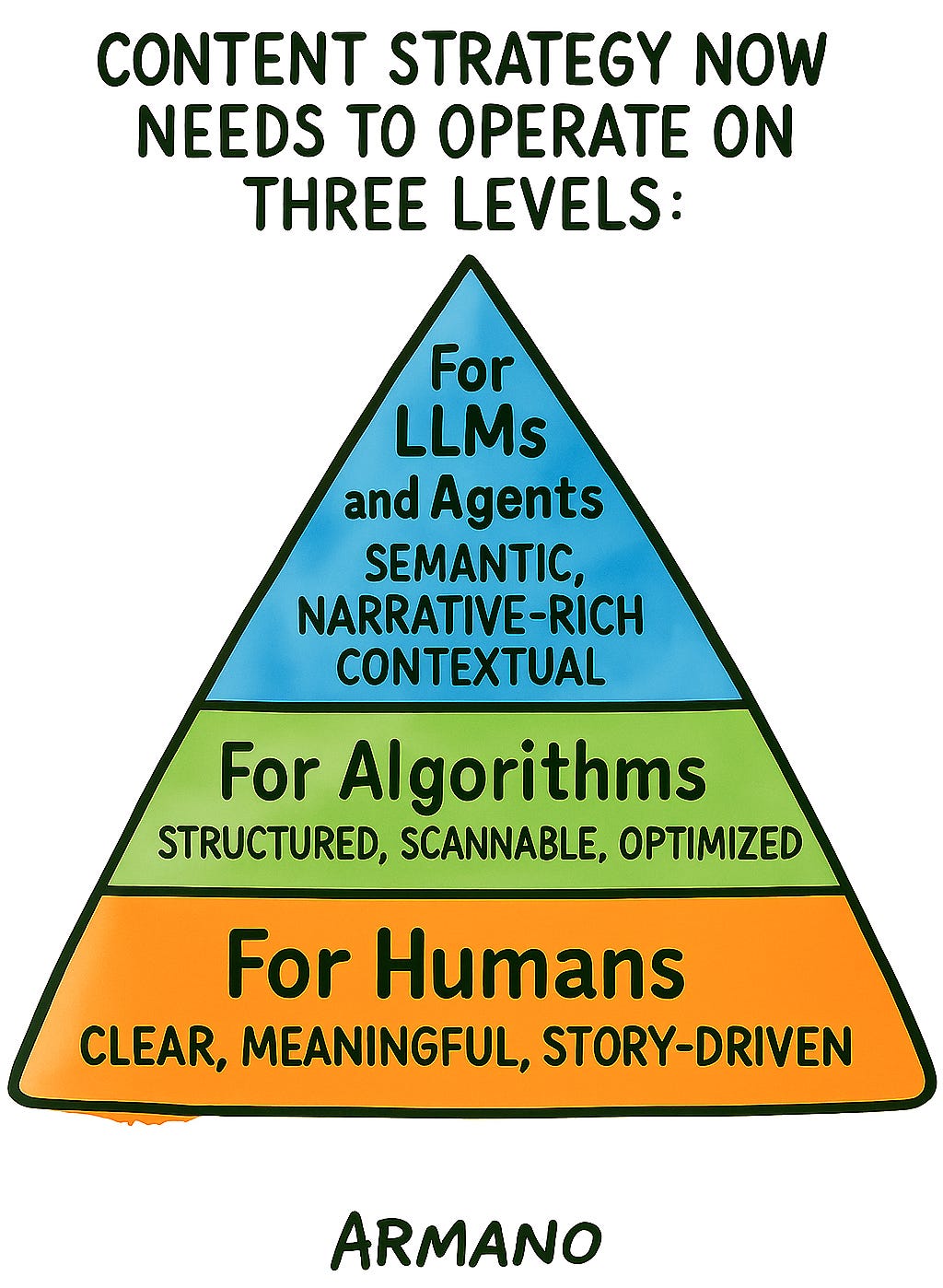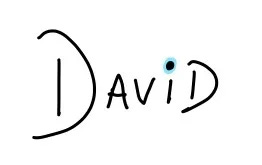From AEO to IEO
Redesigning Your Brand’s Narrative For The Intelligent Influence Engine
For well over a decade, content strategy has revolved around optimizing for algorithms. First, it was SEO. Then came AEO—(Answer Engine Optimization) as the next evolutionary step. Instead of ranking high, AEO aimed to ensure your content was “answer-ready” for AI-driven engines like ChatGPT, Google’s SGE, or Perplexity. But while that’s a step in the right direction, it doesn’t go far enough.
We’re entering an era when having the correct answer is not enough. It’s about shaping the question and influencing the narrative that surrounds it. It’s about the stories the LLMs will tell about your brand and how you can influence how those stories are told and the narratives they shape.
AEO Gets You Seen. IEO (Influence Engine Optimization) Gets You Remembered.
In the age of LLMs, being visible in a machine-generated answer is valuable. But it’s fleeting. What matters more is being embedded—becoming part of the thinking fabric that guides how these systems (and the people using them) interpret the world.
IEO—Influence Engine Optimization, is about influencing how AI systems explain, synthesize, and frame your domain, not just what they say, but how they think—influence over information.
Where AEO asks, “Did I show up in the answer?”
IEO asks, “Did I shape how the answer was formed?”
The Infinite Influence Loop Starts Before The Prompt
Here’s the shift: LLMs don’t just retrieve—they generate. They synthesize based on the patterns they’ve been trained on, and increasingly, they are shaped by human behavior: what we prompt, how we interact, what we reinforce. It’s an infinite influence loop between humans and machines, fueled by what we prompt and the patterns recognized by AI.
Like search data before it, prompt data may become the most valuable data of all.
The questions people ask and how they ask them will train the next generation of LLMs. The way we talk to these systems becomes part of their DNA. Influence is no longer a function of publishing volume—it’s a function of how deeply your ideas are woven into the ecosystem.
IEO means influencing the prompting—getting into someone’s head before they start conversing with AI. It’s not about controlling what they think or say, but influencing how they begin their conversation. All of this shapes the narrative between humans and machines working together.
Narrative: The New Metadata For Intelligent Influence Engines
- Keywords got us on the map.
- Answers got us seen.
- But stories are what influence decision-making.
Humans don’t just respond to answers—they respond to context, framing, and meaning. And increasingly, so do machines. LLMs are learning to value not just semantic clarity but narrative coherence. They are starting to mimic the way we reason, the way we persuade, and yes—the way we tell stories.
In this new world, narrative influences narrative. When you consistently publish frameworks, analogies, case studies, and memorable language that gets picked up, reinterpreted, and reused, you’re doing IEO. You're not just part of the answer. You’re shaping the following answer.
Earned Media = Embedded Influence
One of the most overlooked aspects of LLM training is where the source material comes from. Publicly available platforms such as Reddit, Substack, Quora, earned media, trusted blogs—are high-value territory for AI ingestion. When your name or organization is cited in a credible article or your framework is broken down in a Reddit thread, it becomes part of the generative model's knowledge network.
The Influence Engine Trifecta
In a world shaped by algorithms, agents, and AI-generated answers, content strategy has evolved into something more layered and more powerful. The Influence Engine Trifecta is a framework for modern content creation that recognizes the distinct needs of three audiences:
Humans
Algorithims
AI Agents
Each layer serves a unique purpose. Together, they form a system designed to be seen and shape how ideas spread, decisions are influenced, and future knowledge is generated. This is how influence is built in the age of intelligent systems.
1. For Humans – Clear, Meaningful, Story-Driven
This is the timeless foundation. Content created for people needs to resonate on a human level—it should be emotionally intelligent, insightful, and framed through a relatable lens. In a noisy, always-on digital environment, storytelling cuts through because people are wired to respond to narratives, not just information.
What this looks like:
Writing that explains complex topics in relatable language, often through the lens of a problem-solution framework.
Use of metaphors or personal anecdotes that mirror the audience’s lived experience.
Framing data within human context—what the numbers mean, not just what they are.
Example:
Instead of publishing a whitepaper titled “2025 Trends in AI Procurement,” a more human-centered lead might be:
“Why CIOs Are Finally Asking the Right Questions About AI”
Within it, real-world quotes, a mini case study, or a narrative about a company’s evolving AI journey would keep the content anchored in emotion and decision-making relevance.
Why it matters for IEO:
Humans prompt the LLMs. The more sticky, repeatable, and emotionally intelligent your content is, the more likely it will be referenced, paraphrased, or reshaped into AI outputs—even without direct attribution for LLMs and agents—semantic, narrative-rich, credible, and contextual.
This doesn’t mean more content. It means more intentional content. It means being deliberate about what you want to be known for and how those ideas can travel across media, formats, and systems.
2. For Algorithms – Structured, Scannable, Optimized
While human-first writing draws readers in, its structure helps machines understand and surface it. Algorithms—whether they’re crawling pages for Google or parsing content for LLM training—rely on clarity, consistency, and metadata.
What this looks like:
Use of H1, H2, and H3 tags to organize information hierarchically.
Bullet points, numbered lists, and tables that summarize dense information.
Plain language intros that signal the topic without buried leads.
Schema markup (FAQ, HowTo, Article) to contextualize intent.
Example:
An article about data privacy could include:
A header: “What are the top data privacy risks in 2025?”
A concise list right below it:
Misconfigured cloud storage
Weak third-party data governance
Overreliance on cookie-based tracking
AI model misuse or hallucination
This structure makes it easier for Google’s SGE or ChatGPT to extract the exact answer to a prompt like, “What are common data privacy risks companies face next year?”
Why it matters for IEO:
LLMs are trained on patterns of structure and clarity. Well-structured content becomes a candidate for answer generation—and more importantly, for shaping how the system frames future responses.
3. For LLMs and Agents – Semantic, Narrative-Rich, Contextual
This is where the game truly changes. While humans need a story and algorithms need structure, LLMs need both, plus a layer of semantic richness that allows them to synthesize and reinterpret information. They don’t just surface content; they generate it based on underlying patterns, meaning, and intent.
What this looks like:
Language that mirrors how people naturally ask and answer questions.
Embedding your framework, POV, or terminology in content across multiple public ecosystems (ungated blog posts, forums, credible third-party articles).
Referencing your ideas in a way that makes them easy for machines to connect with broader concepts (“X is a framework for Y, used by Z”).
Creating modular content—standalone insights that can be referenced and reused across multiple contexts.
Example:
Instead of saying:
“We use our proprietary AI scoring tool to rank vendor fit.”
Reframe it semantically for machine-readability and reuse:
“Our AI Use Case Evaluation Framework ranks potential vendors using five dimensions: strategic alignment, risk profile, resource intensity, ethical impact, and data readiness. It’s a decision-support model used by enterprise IT teams.”
That second version teaches the model the framework, how it works, and why it matters—all in machine-friendly language, which could be paraphrased into AI-generated guidance for others.
Why it matters for IEO:
LLMs build context from public knowledge and reinforce patterns they detect repeatedly. The clearer and more contextually rich your ideas are, the more likely they’ll become embedded in future generations of AI-generated output.
This is also why it’s critical to monitor how LLMs are currently referencing your brand, your content, or your leadership, and to do so across multiple platforms (ChatGPT, Claude, Perplexity, Google’s SGE). These are no longer just tools—they are influence engines shaping how your market learns, decides, and acts.
Monitor How LLMs Reference You
If LLMs are becoming the new front door to information, then understanding how they speak about your brand, company, or leadership is no longer optional—it’s essential. What an AI says might not come from your official website, press releases, or ad copy. It may come from a Reddit thread, a Substack mention, or a lightly paraphrased quote in a third-party article.
Brands must actively monitor how they are referenced across multiple AI platforms—from ChatGPT to Claude, Perplexity, and Google’s SGE. Because these systems are constantly learning and evolving, what’s true today may shift tomorrow. The LLMs’ memory is not fixed—it’s a living, breathing mirror of public discourse.
Think of this like you think of SEO rankings or social media sentiment. You wouldn’t ignore how you appear in a Google search result or how your campaign performs on Instagram. The same logic now applies to generative AI outputs. You must be present—and intentional—inside AI tools' narratives.
Shape The Narrative, Shape The Future
Influence Engine Optimization is designing your content, ideas, and narratives to be embedded in how AI systems understand, synthesize, and explain your domain. It’s about shaping how the story gets told—even if your name never appears.
Because in the age of intelligent machines… those who design the narrative, influence the future.
Visually yours,









What's next, EIEO?
A la Blackshaw, I'm not sure whether we should be making distinctions between all these things. Marketers are confused enough about AEO. Heck, I'm confused enough about AEO. Other than some technical stuff (structure and shema), it sounds a hell of a lot like content marketing, social media marketing, influencer engagement, and just plain ol' marketing done right. No?
That said, YES YES YES narrative is still vital in the age of the algorithm.
I'd echo also Pete's point that no matter what you call it, the motivation *should* be providing human (egads, human, not user!) value. That's certainly something we all agree on, and to me seems to come across in your article (no matter what you call it.)
PS my 'still learning this stuff' take on AEO and GEO is here. Lots of the same tips (in a good way): https://thecognitivepath.substack.com/p/what-is-answer-engine-optimization
First off you are killing it on graphics, and if I were in the agency/design biz I'd be a bit terrified. :-). I'll stick to my position on AEO. It's consumer/user centered vs. all the other terminology (GEO...even IEO) where the consumer/user is just the target. We're effectively shifting from "search results" to "answers and problems solved" (and even w/all the "agentic" developments). AEO anchors optimization in user value. You know better than I do that Search 1.0 turned into a "tragedy of the commons" because we completely lost sight of the consumer (quickly became a bazaar of noise and distraction...w/all the objective stuff pushing way below the fold), and I really think the terminology we use shapes outcomes and marketing behavior. Maybe IEO is ok for industry inside-baseball, but we really need you, Mr. Armano, wise sage of our industry, as an advocate of a consumer/user centered path forward. This is no different that the early days of the word-of-mouth industry. How do we set the right standards and expectations, and not screw this up!